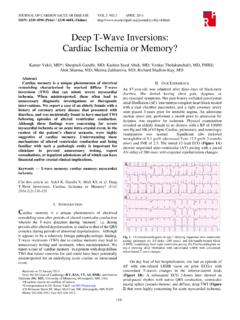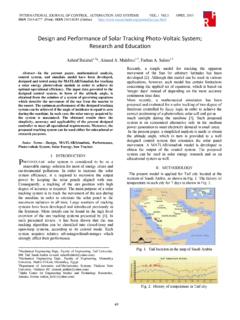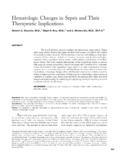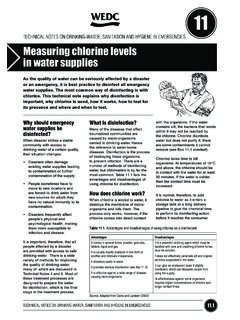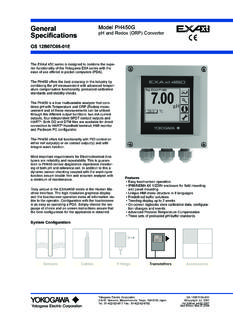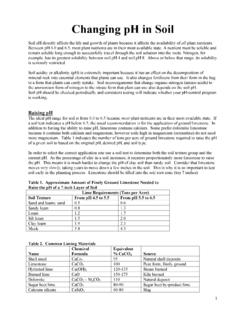Transcription of The Effects of High HCl and Changes in pH Levels in CDU ...
1 Journal of Applied and Industrial Sciences, 2014, 2 (5): 238-243, ISSN: 2328-4595 (PRINT), ISSN: 2328-4609 (ONLINE) Research Article 238 Abstract many corrosion management methods for Alfulla treatment had been investigated .Corrosion inhibitors and neutralizer in addition to high efficient desalting have been proposed as the superior corrosion treatment technique for Alfulla crude processing equipment. Generally the overhead of a crude unit can be subjected to a multitude of corrosives species . Hydrochloric acid, formed from the hydrolysis of calcium and magnesium chlorides, is the principal strong acid responsible for corrosion in crude unit overhead.
2 Mitigation of this type of corrosion is performed by process Changes , materials upgrading, design Changes , and injection of chemicals such as neutralizers and corrosion inhibitors. Process Changes include any action to remove or at least reduce the amount of acid gas present and to prevent accumulation of water on the tower trays. Material upgrading includes lining of distillation tower tops with alloys resistant to hydrochloric acid. Design Changes are used to prevent the accumulation of water. They include coalesces and water draws. The applications of chemicals include the injection of a neutralizer to increase the pH and a corrosion inhibitor. This investigation proved that maintaining a low chloride level and stable pH Levels were the most effective ways to control equipment damage from corrosion.
3 Also, the study found that several inspection techniques were particularly useful in estimating service life for pipes and other crude-unit equipment. Applying better pH control and improved monitoring and inspection programs can reduce equipment damage from corrosion. In this study, some field results are presented, including chemical analysis, pH and corrosion rate for a CDU tower overhead in Viscosity Breaking Unit. Index Terms Corrosion rate, pH, Neutralizer, HCl. I. INTRODUCTION significant corrosion problems have been reported in crude unit overhead operations, including those due to chloride and sulfur species in the crude [1]. Most of these problems, such as those due to NH4Cl or HCl have been dealt with after the damage has occurred, and continue to be a source of significant material degradation in CDU overhead operations [2].
4 Chloride salts are found in most production wells, either dissolved in water emulsified in the crude oil or as suspended solids. Salts also originate from salt water injected for secondary recovery or from seawater ballast in marine tankers [3]. The amount of salt contained in the emulsified water may range from 10 pounds to 250 pounds per thousand barrels of crude oil. The salt typically contains 75% sodium chloride, 15% magnesium chloride, and 10% calcium chloride corrosion is caused by the presence of hydrogen chloride. Hydrogen chloride evolves from heating magnesium chloride and calcium chloride to above 300 0F (149 0C). Sodium chloride is essentially stable up to about 8000F (426 0C) [4]. Hydrogen chloride evolution occurs primarily in the crude preheat furnace.
5 Dry hydrogen chloride is not corrosive to carbon or low alloy steel, especially when large amounts of hydrocarbon vapor or liquid are present. However, when steam is added to the bottom of the crude tower to facilitate the distillation process, dilute hydrochloric acid is produced [3]. The hydrochloric acid can cause severe corrosion in carbon steel equipment at temperatures below the initial water dew point [5]. The corrosion rate increases with a decrease in water pH [6]. Alfulla Crude Oil properties Alfulla crude from South Kurdufan area wells has such properties: High calcium content, high acid value, high water content, high density and viscosity [7]. These properties need to be reduced to a minimum; to improve the product quality [8].
6 Alfulla has quite different characteristics, depending of the time of sampling and analytical lab performing [7]. It is especially related to TAN, viscosity, Fe, Ca and specific gravity. High quality corrosion monitoring and control must be celebrated and adjusted to give optimum units performance with the ever- changing properties of crude [8]. For crude-unit overhead systems, pH is the main process parameter that impacts corrosion rates [9]. To control corrosion conditions, many operators use various neutralizers at optimum ranges determined by site-specific conditions [10]. A three-year study (2011 2014) was conducted at a VBU using amine-blend solutions to control pH. Over this period, corrosion rates were measured through ultrasonic inspections and weight-loss coupons [7].
7 II. M ATER I AL S A ND M E T H O DS LAB O R A T O R Y ME T H O D S The laboratory test methods should be carried out under conditions that simulate operational conditions in the field, including composition of material and environment, temperature, flow, pressure, and the method by which the inhibitor is added, continuous or batch. The simplest, and longest-established, method of estimating corrosion losses in The Effects of High HCl and Changes in pH Levels in CDU Overhead Corrosion Elnour *1, Gasmelseed *2, Karama *3 (1-3)University, Of Karari, Sudan, Department of Chemical Engineering. 2. Email: 3 Email: (Received: May 31, 2014; Accepted: September 28, 2014) S 1* corresponding author Email: 239 Journal of Applied and Industrial Sciences, 2014, 2 (5): 238-243, ISSN: 2328-4595 (PRINT), ISSN: 2328-4609 (ONLINE) plant and equipment is weight loss analysis [11].
8 A weighed sample (coupon) of the metal or alloy under consideration is introduced into the process, and later removed after a reasonable time interval. The coupon is then cleaned of all corrosion products and is reweighed. The weight loss is converted to a corrosion rate (CR) or a metal loss [8]. Field data First year, the observed corrosion rates in pipes, were obtained from thickness measuring via ultrasonic testing. Corrosion rates reached values of mm/yr. Some thickness loss and stress-corrosion cracking were also reported on the safety vents of the CDU, which can be attributed to H2S Levels (2,553 ppm) in the neutralizing solution used. Second year, high chloride Levels , caused by inefficiencies in the crude preparation and desalting processes, generated high corrosion rates, the average corrosion rate observed by the coupon weight loss over two years was mm/yr.
9 The pipes connecting the top of the atmospheric tower and condensers have flaws from previous campaigns. Localized under-deposit corrosion in the lower blank of the condenser shell was observed. Third year, monitoring results for coupons installed in the overhead, had average corrosion losses of mm/yr. This reflects a uniform thickness loss expected in equipment and pipes. But there were failures in reflux pipes caused by localized under-deposit corrosion. The average service life was five years, and failures were reported immediately after the flow entrance, where condensation begins. Thickness measuring For this study, two regions of the overhead pipe were selected at train A to conduct thickness measurement via ultrasonic testing [11].
10 Initially, the testing was separated into two areas: Overhead atmospheric tower and condenser Between the condenser and accumulator drum. Different behaviors are expected from the pipes carrying the fluid before the condenser in the vapor phase (by design), then after, where the water is already in liquid phase. Thus, the observed corrosion rates were different, as shown in Fig. 1. Figure 1. CDU showing locations identified for thickness monitoring by ultrasonic testing The locations for thickness measurement are always chosen based on the experience of the inspection team supervising the unit and the measurements usually apply these aspects: In the curves, the corrosion rates may be higher due to an increased propensity for the occurrence of corrosion associated with erosion.


